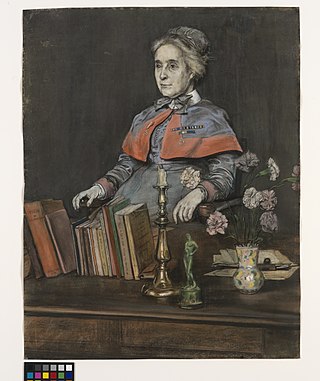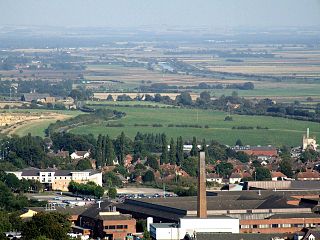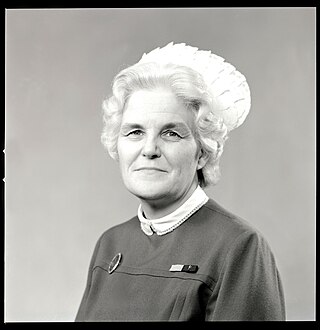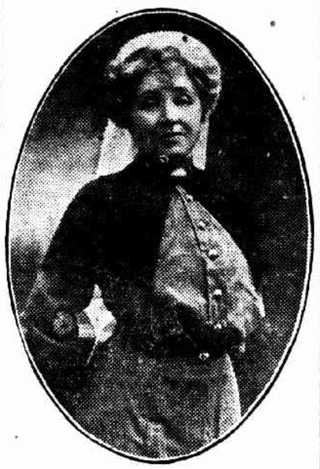Related Research Articles

Ethel Gordon Fenwick was a British nurse who played a major role in the History of Nursing in the United Kingdom. She campaigned to procure a nationally recognised certificate for nursing, to safeguard the title "Nurse", and lobbied Parliament to pass a law to control nursing and limit it to "registered" nurses only.

Dame Sarah Ann Swift, GBE, RRC was an English nurse and founder in 1916 of the College of Nursing Ltd. which became the Royal College of Nursing. The College of Nursing created the first registers of nurses, a blueprint for the introduction of Nurse registration in the United Kingdom.

Dame Alicia Frances Jane Lloyd Still, was a British nurse, teacher, hospital matron and leader of her profession. She was one of the leaders in the campaign for state registration of nurses. Following the Nurses Registration Act 1919, she was a member of the General Nursing Council (1920-1937). As chairwoman of the General Nursing Council's first Education and Examinations Committee she helped establish the first national examination standards for the registration of nurses.

Dame Sidney Jane Browne, was the first appointed Matron-in-Chief of the newly formed Queen Alexandra's Imperial Military Nursing Service (QAIMNS). After she retired from the QAIMNS she was appointed as Matron-in-Chief of the Territorial Force Nursing Service. Browne was appointed a Dame Grand Cross of the Order of the British Empire in 1919 and, in 1922, she became the first President of the Royal College of Nursing, a post she held until 1925.

Eva Charlotte Ellis Luckes was matron of the London Hospital from 1880 to 1919.

Lincoln County Hospital is a large district general hospital on the eastern edge of north-east Lincoln, England. It is the largest hospital in Lincolnshire, and offers the most comprehensive services, in Lincolnshire. It is managed by the United Lincolnshire Hospitals NHS Trust.
Olive Eva Anstey was an Australian hospital matron.
Alice Hannah Holford was a New Zealand nurse, midwife and hospital matron.

Isla Stewart was an English hospital matron of St Bartholomew's Hospital in London and a founding member of the Royal British Nurses' Association.
The history of nursing in the United Kingdom relates to the development of the profession since the 1850s. The history of nursing itself dates back to ancient history, when the sick were cared for in temples and places of worship. In the early Christian era, nursing in the United Kingdom was undertaken by certain women in the Christian Church, their services being extended to patients in their homes. These women had no real training by today's standards, but experience taught them valuable skills, especially in the use of herbs and folk drugs, and some gained fame as the physicians of their era. Remnants of the religious nature of nurses remains in Britain today, especially with the retention of the job title "Sister" for a senior female nurse.
Annie Warren Gill & Bar was a British nurse who served as president of the College of Nursing in 1927.
Susan Villiers (1863–1945) was an English nurse who specialised in caring for patients with infectious diseases in fever hospitals, also known as isolation hospitals. She was a leading figure in the drive for better nursing education and a better-organised nursing profession, especially for fever nurses. As well as being matron of various fever hospitals, she was on the council of the Fever Nurses Association from its beginning in 1908, and she played important roles in various other organisations working towards registration of qualified nurses, better training and other improvements for the profession.
The Royal British Nurses' Association was founded in December 1887 by Ethel Bedford-Fenwick, with leading matrons from voluntary, local authority and military hospitals including; Isla Stewart of St Bartholomew's Hospital, Godiva Thorold of the Middlesex Hospital, Miss Hogg of Haslar Hospital and Anne Gibson of Brownlow Hill Infirmary, Liverpool

Erna von Abendroth was a pioneering German nurse and trainer/teacher. After the First World War she became the first German nurse to receive a PhD degree in return for a dissertation with a nursing theme. After the Second World War, starting in May 1946 she took charge of the reconstruction of the "Werner" Red Cross Nursing Academy at Göttingen.
Rosalie Dreyer was a Swiss-born naturalised British nurse and administrator. Immigrating to England at the age of eighteen, she trained as a nurse in London and worked her way through the ranks to become matron, principal matron and chief matron-in-charge of the Nursing Service of the London County Council. Dreyer was a pioneer in the development of Britain's public-funded nursing service.

Mary Kathleen Robb, OBE, OStJ, FRCN, was a nurse from Northern Ireland. Robb was the last matron of the Royal Victoria Hospital in Belfast and steered nursing services across the city during the height of The Troubles. Robb was an advocate for the Royal College of Nursing (RCN) and was a board member for 20 years.

Adelaide Maud Kellett, was an Australian army nurse and hospital matron. She served with the Australian Army Nursing Service in the First World War and was matron of Sydney Hospital from 1921 to 1944.
City of Glasgow Fever and Smallpox Hospitals (Belvidere), Glasgow, Scotland were established in 1870 and closed in 1999.

Godiva Marian Thorold was a British nurse, matron, and as a founding member of the British Nursing Association influential in the development of the nursing profession in the United Kingdom.
References
- ↑ "The Passing of the Fever Nurses' Association". The Nursing Record. 82 (1986): 20. 1934.
- ↑ Currie, Margaret (2013). Fever Hospitals and Fever Nurses: A British Social History of Fever Nurses. Routledge. p. 32. ISBN 9781134265268.
- ↑ "The Passing of the Fever Nurses' Association". The Nursing Record. 82 (1986): 20. 1934.
- ↑ Abel-Smith, Brian (1960). A History of the Nursing Profession. London: Heinemann. p. 81.
- ↑ Hopkinson, Beatrice (2015). Nursing Through Shot & Shell: A Great War Nurse's Story. Pen and Sword. ISBN 9781473861985.
- ↑ "Nurses of Note". The Nursing Record. 1966: 115. May 1932.
- ↑ "The Passing of the Fever Nurses' Association". The Nursing Record. 82 (1986): 20. 1934.
- ↑ "Biernacki, J. "Fever Nurses' Association."". The Nursing Record. 56 (1473): 550. 24 June 1916.
- ↑ "Appointments". Nursing Notes. 4: 100. July 1891.
- ↑ "Nursing Echoes". The Nursing Record. 10 (271): 281. 8 June 1893.
- ↑ "Drakard, Minnie. "The Passing of a Nursing Pioneer". The Nursing Record. 2071: 33. February 1941.
- ↑ "Nurses of Note". The Nursing Record. 80 (1966): 115. May 1932.
- ↑ "Nurses of Note". The Nursing Record. 1966: 115. May 1932.
- ↑ "Drakard, Minnie. "The Passing of a Nursing Pioneer". The Nursing Record. 89 (2071): 33. February 1941.